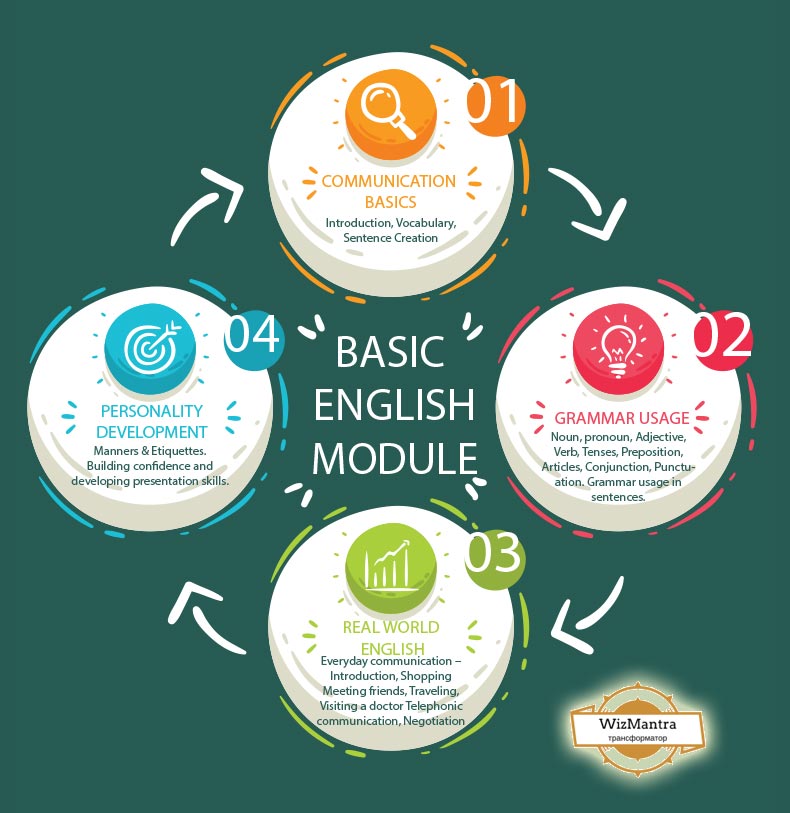
English Classes for Kids
Age Eligibility: 6-14 Years; Std:2-12
The English speaking programs offered by WizMantra for young people are meant especially to increase children’s communication confidence. These online English classes for kids provide a balanced approach to language development, enabling young students to communicate effectively in real-world contexts. Our English speaking courses for children focus on developing essential speaking, listening, reading, and writing abilities. Young learners engage with well-organized material covering grammar, vocabulary, pronunciation, idioms, and colloquial expressions through interactive English lessons for young learners. With custom content that supports basic online English learning in an engaging and effective manner, this virtual English tutoring for kids is ideally suited for students from Std-1 through Std-10. Course is well suited for Kids in Std-1, Std-2, Std-3, St-4, Std-5, Std-6, Std-7, Std-8, Std-9, Std-10.
English Kids Classes
1 Month
✅ Live Interactive Kids Sessions
✅ Basic Grammar & Vocabulary for Kids
✅ Speaking & Listening Practice for Kids
✅ Performance Feedback- Parents Meet
Kids Classes
2 Months
✅ Live Interactive Sessions
✅ Basic Grammar & Vocabulary
✅ Speaking & Listening Practice
✅ Performance Feedback
Kids Online Classes
3 Months
✅ Live Interactive Sessions
✅ Basic Grammar & Vocabulary
✅ Speaking & Listening Practice
✅ Performance Feedback
Syllabus of Kids Online Spoken English Modules
- Lesson 1 – Mixed Present Tenses
- Lesson 2 – Simple Past & Present Perfect
- Lesson 3 – Mixed Past Tenses
- Lesson 4 – Mixed Future Tenses (Basic)
- Lesson 5 – Mixed Future Tenses (Basic +2)
- Lesson 6 – Transitive / Intransitive Verbs + Objects
- Lesson 7 – Verbs + TO or ING with a change in meaning
- Lesson 8 – Passive Voice
- Lesson 9 – Subject-Verb Agreement with Tricky Nouns
- Lesson 10 – Subject-Verb Agreement with Complex Subjects & Quantifiers
- Lesson 11 – Countable & Uncountable Nouns
- Lesson 12 – Complete Guide to Articles
- Lesson 13 – There & It
- Lesson 14 – Compound Nouns
- Lesson 15 – Adjectives & Adverbs
- Lesson 16 – Position of Adverbs
- Lesson 17 – Questions (Part 1)
- Lesson 18 – Questions (Part 2)
- Student who have studied < 12 standard
- Senior & Middle level Government Employee
- Senior Middle level private firm executives
English Speaking Course Objectives for Kid
The main objective of the syllabus and pattern covered in Basic Kids English Speaking Module is
• To provide engagement to the students so that they can pronounce more for new and existing vocabularies.
• To provide them schedule so that they can read more of their own
• To provide Kids the schedule to write daily for their writing improvements
• To establish an environment for Kids where they can develop their listening skills
• To establish etiquette so that Kids can comfortably work on their social and professional surroundings
English Speaking Courses for Kids
In today’s competitive world, strong communication skills are essential—even from a young age. Whether your child is preparing for school presentations, interviews, or simply needs more fluency, our interactive English lessons for young learners are the perfect solution. You can also check here for customized kids grammar classes
Through personalized virtual English tutoring for kids, our expert tutors work on vocabulary, grammar, pronunciation, and sentence formation every day. We help your child gain confidence in speaking English fluently—while also saving valuable time for their academic growth.
Learning is a captivating journey tailored for young minds. Our diverse range of kids classes is designed to ignite curiosity, foster creativity, and develop essential skills. From online English speaking courses for kids to explorations in foreign languages like French, German, and Spanish, we’re here to inspire and educate your child in a holistic manner.
Unlock Language Fluency and Confidence in Kids
Empower your child’s linguistic journey with our online English speaking course for kids. Through interactive sessions and engaging activities, we lay the foundation for effective communication and self-expression for your Kid. Your child will not only learn the intricacies of the language but also gain the confidence to express themselves fluently in English.
Embark on Multilingual Kids Adventures
Beyond English, our spectrum of kids English classes offers opportunities for cross-cultural exploration. Delve into the poetic elegance of French or unravel the mysteries of German. Our expert instructors make learning these languages an exciting journey, enhancing your child’s cognitive abilities while expanding their horizons.
Cultivate Heritage with Kids Hindi Classes
For those seeking to connect with their roots, our Hindi classes celebrate the richness of the language. Whether your child is a beginner or already familiar with Hindi, our courses cater to different proficiency levels, ensuring a personalized learning experience.
Spark a Passion for Spanish
Ignite your child’s passion for languages with our Spanish classes for kids. The vibrant and melodious Spanish language becomes a gateway to understanding diverse cultures. Our classes are carefully designed to make language acquisition enjoyable and effective.
At WizMantra, we understand that learning need for each kid is unique, with their own pace and interests. Our kids classes aren’t just about imparting knowledge; they’re about nurturing a lifelong love for learning. Join us in creating a foundation for your child’s academic success and personal growth through our engaging and enriching courses.
Online 2nd Language Courses for Kids
English Language Courses

3 levels of Kids English courses for Age 5-16. Customize Kids classes according to your need and Let Kid become confident in English in 60 days.
French Language Courses

Learn French (Francais) online with specialize French trainers, French course is distributed across multiple levels & can be customized as per your Child need.
Hindi Language Courses
 Levels
Levels
Basic A & BInt A & BAdv A
Learn Hindi language online, online courses to meet your basic to advance communication needs. Start speaking Hindi with confidence.
Spanish Language Courses
Levels
BasicInt A & BAdv A & B
Learn SPANISH (Espanol). Online interactive training on spanish; spread across Basic, Intermediate and Adv levels. Custom Kids module as per age.
English Courses for Kids Age 6 to Age 17
English Course Title: Tiny Tots Kids English Adventure
Overview: In this delightful English adventure, preschoolers will embark on a journey of discovery, exploring the wonders of language through engaging activities, stories, and interactive play. The focus is on creating a positive and fun environment that fosters a love for learning.
Kids English Course Content:
- Introduction to Basic Vocabulary:
- Introduce simple and commonly used words such as colors, numbers, animals, and everyday objects.
- Interactive activities like flashcards, games, and storytelling to reinforce vocabulary.
- Phrases through Playful Interaction:
- Teach basic phrases and expressions used in daily communication through fun and interactive role-playing activities.
- Incorporate songs and rhymes to make learning enjoyable and memorable.
- Storytime Adventures:
- Explore short, age-appropriate stories with colorful illustrations.
- Encourage participation by asking questions related to the story and introducing basic storytelling elements.
- Creative Arts and Crafts:
- Combine language learning with creativity through arts and crafts projects.
- Engage in activities like drawing, coloring, and crafting related to the day’s lesson.
- Interactive Games:
- Incorporate educational games that enhance vocabulary, concentration, and social skills.
- Games like word association, matching, and simple puzzles to make learning dynamic.
- Language through Music:
- Use songs and musical activities to introduce rhythm, sounds, and language patterns.
- Sing-along sessions with catchy tunes to reinforce vocabulary and pronunciation.
- Celebrating Progress:
- Implement a positive reinforcement system with stickers or small rewards to celebrate achievements and encourage participation.
End Goal: By the end of the Tiny Tots English Adventure, preschoolers Kids will have developed a foundation in basic English vocabulary, expressions, and communication skills. The course aims to instill a love for learning and lay the groundwork for their future language development.
Kids Course Title: Phrases through Playful Interaction
Objective: The aim of this segment is to familiarize preschoolers with simple and essential phrases used in daily communication, making the learning process enjoyable and interactive.
Kids English Course Content:
- Greetings and Polite Expressions:
- Activity: Circle Time Greetings
- Preschoolers will learn basic greetings like “hello,” “goodbye,” and “please” through a daily circle time routine.
- Incorporate interactive elements like hand gestures and facial expressions to make greetings engaging.
- Activity: Circle Time Greetings
- Everyday Conversational Phrases:
- Activity: Play Kitchen Conversations
- Set up a pretend kitchen area with play food and utensils.
- Guide children in using simple phrases like “I want,” “please,” and “thank you” during pretend cooking and sharing activities.
- Activity: Play Kitchen Conversations
- Expressing Emotions:
- Activity: Emotion Puppet Play
- Introduce basic emotions such as happy, sad, and excited using puppets or expressive facial expressions.
- Encourage children to use phrases like “I’m happy” or “I’m sad” to express their feelings.
- Activity: Emotion Puppet Play
- Interactive Storytelling:
- Activity: Storytelling with Expression
- Use interactive storytelling sessions to incorporate phrases within the narrative.
- Encourage children to repeat and use phrases related to the story, enhancing comprehension and expression.
- Activity: Storytelling with Expression
- Role-Playing Scenarios:
- Activity: Pretend Play Corner
- Create themed play corners (e.g., a doctor’s office, a grocery store) to encourage role-playing.
- Guide children to use phrases like “How can I help you?” or “May I have some apples, please?”
- Activity: Pretend Play Corner
- Songs and Movement:
- Activity: Sing-Along Expressions
- Introduce songs with expressive lyrics that include common phrases.
- Incorporate simple movements or actions to engage children while singing and learning phrases.
- Activity: Sing-Along Expressions
Integration with Other Activities:
- Ensure that phrases learned are seamlessly integrated into other activities, such as storytime, arts and crafts, and games, to reinforce their usage in different contexts.
End Goal: Preschoolers completing this segment will gain confidence in using basic English phrases in everyday interactions. The emphasis on playful activities ensures that learning is enjoyable and memorable, setting the foundation for effective language communication.
Kids Course Title: Storytime Adventures
Course Objective: The goal of this segment is to immerse preschoolers in the enchanting world of storytelling, fostering a love for language through engaging narratives, colorful illustrations, and interactive discussions.
Kids Course Content:
- Theme-based Story Sessions:
- Activity: Weekly Story Themes
- Introduce a new theme each week (e.g., animals, colors, friendship) to structure storytime sessions.
- Select age-appropriate picture books that align with the theme for the week.
- Activity: Weekly Story Themes
- Interactive Reading:
- Activity: Read-Aloud with Expression
- Use animated and expressive reading to capture the children’s attention.
- Pause at key points to ask questions and encourage participation. For example, “Can you find the red apple in the picture?”
- Activity: Read-Aloud with Expression
- Prop-Assisted Storytelling:
- Activity: Storytelling Props
- Use props or puppets related to the story to make it more interactive.
- For instance, if the story involves a farm, bring out small toy animals for children to touch and play with.
- Activity: Storytelling Props
- Story Retelling:
- Activity: Group Story Retelling
- After reading a story, encourage children to retell parts of it using their own words.
- This enhances comprehension and language recall while promoting creativity.
- Activity: Group Story Retelling
- Create-Your-Own Story:
- Activity: Art and Storytelling
- Combine storytelling with arts and crafts.
- After a story session, let children create their own illustrations or crafts inspired by the story, accompanied by simple verbal expressions.
- Activity: Art and Storytelling
- Story Sequencing:
- Activity: Picture Sequencing
- Provide sets of pictures depicting key events from a story.
- Encourage children to arrange the pictures in the correct sequence, promoting narrative understanding.
- Activity: Picture Sequencing
- Themed Story Discussions:
- Activity: Group Discussions
- Engage children in discussions about the story, asking questions about characters, events, and feelings.
- This enhances comprehension and encourages the use of descriptive language.
- Activity: Group Discussions
Integration with Other Activities:
- Integrate storytime adventures with related activities, such as creating themed crafts, playing storytelling games, or even acting out parts of the story through simple role-playing.
End Goal: Preschoolers completing this segment will develop a love for storytelling, enhanced listening skills, and improved comprehension. The interactive elements ensure that storytime becomes a cherished part of their language-learning journey, laying the groundwork for future literacy skills.
Kids Course Title: Creative Arts and Crafts
Objective: The aim of this segment is to engage preschoolers in hands-on, creative activities that reinforce language concepts learned during the course. Through arts and crafts, children will not only enhance their fine motor skills but also express themselves using English vocabulary.
Kids English Course Content:
- Themed Craft Projects:
- Activity: Weekly Craft Themes
- Align craft projects with the weekly themes introduced in the course (e.g., animals, nature, shapes).
- For example, if the theme is animals, create simple paper plate animal masks or handprint animals.
- Activity: Weekly Craft Themes
- Vocabulary Building with Materials:
- Activity: Labeling and Sorting
- Introduce new vocabulary by labeling craft materials (e.g., paper, glue, colors).
- Incorporate sorting activities where children categorize materials based on color or shape.
- Activity: Labeling and Sorting
- Story-Inspired Crafts:
- Activity: Crafty Story Creations
- Connect craft projects with stories read during the course.
- For instance, if a story features a rainbow, create a rainbow craft using different colored paper or paint.
- Activity: Crafty Story Creations
- Expressive Art Activities:
- Activity: Finger Painting and Handprint Fun
- Use finger painting or handprint activities to explore different textures and colors.
- Encourage children to describe their creations using simple English phrases.
- Activity: Finger Painting and Handprint Fun
- Building Simple Structures:
- Activity: Building with Blocks
- Incorporate building blocks or construction paper to create simple structures.
- Teach basic spatial concepts like “on top,” “underneath,” and “beside” during the activity.
- Activity: Building with Blocks
- Collage Creations:
- Activity: Theme-based Collages
- Provide a variety of materials (magazines, fabric scraps, colored paper) for creating collages.
- Encourage children to express themselves by talking about their collage using basic descriptive words.
- Activity: Theme-based Collages
- Seasonal and Holiday Crafts:
- Activity: Seasonal Celebrations
- Introduce crafts related to different seasons and holidays.
- For example, create paper snowflakes in winter or colorful flowers in spring.
- Activity: Seasonal Celebrations
Integration with Language Learning:
- During each craft session, incorporate language learning by discussing the colors, shapes, and materials being used.
- Use descriptive language to narrate the steps of the craft activity, reinforcing vocabulary.
End Goal: Preschoolers completing this segment will not only develop their artistic and fine motor skills but also express themselves confidently using English vocabulary. The integration of language learning with creative activities ensures an enjoyable and holistic learning experience for young learners.
Kids Course Title: Interactive Games
Objective: The goal of this segment is to make learning English enjoyable and interactive through age-appropriate games that promote vocabulary development, concentration, and social interaction among preschoolers.
Kids English Class Content:
- Word Association Games:
- Activity: Picture-Word Matching
- Use flashcards with simple images of everyday objects and corresponding words.
- Encourage children to match the pictures with the correct words, promoting word association.
- Activity: Picture-Word Matching
- Memory Matching Games:
- Activity: Vocabulary Memory
- Create a memory matching game with cards featuring pairs of related images or words.
- This game enhances concentration and memory while reinforcing vocabulary.
- Activity: Vocabulary Memory
- Color and Shape Recognition:
- Activity: Color and Shape Hunt
- Hide colored shapes around the play area.
- Instruct children to find specific colors or shapes, incorporating descriptive language (e.g., “Find the red circle”).
- Activity: Color and Shape Hunt
- Simon Says with English Commands:
- Activity: English Simon Says
- Play a version of Simon Says using English commands.
- For example, “Simon says touch your nose” or “Jump up and down,” encouraging children to follow instructions in English.
- Activity: English Simon Says
- Nature Scavenger Hunt:
- Activity: Outdoor Exploration
- Take the class outdoors for a nature scavenger hunt.
- Encourage children to find and name natural objects in English, such as “flower,” “tree,” or “rock.”
- Activity: Outdoor Exploration
- Storytelling Dice:
- Activity: Story Cubes
- Use storytelling dice with images or words.
- Roll the dice, and have children create a short story using the images or words that appear, promoting creativity and language expression.
- Activity: Story Cubes
- Alphabet Obstacle Course:
- Activity: Letter Obstacle Course
- Set up an obstacle course with large letters on the ground.
- Instruct children to hop from one letter to another, naming each letter they land on.
- Activity: Letter Obstacle Course
Integration with Language Learning:
- During each game, use English instructions and encourage children to respond in English.
- Incorporate vocabulary related to the games into everyday conversations, reinforcing learning in different contexts.
End Goal: Preschoolers completing this segment will not only have improved vocabulary but also enhanced concentration, social interaction, and language expression. The incorporation of games ensures a dynamic and engaging language-learning experience for young learners.
Kids Course Title: Storytelling Dice
Objective: The aim of this segment is to spark creativity and language expression in preschoolers through the use of storytelling dice. By rolling dice with images or words, children will be encouraged to create imaginative and expressive stories in English.
Kids English Class Content:
- Introduction to Storytelling Dice:
- Activity: Dice Introduction Session
- Begin by introducing colorful and engaging storytelling dice with images or simple words.
- Encourage children to touch and explore the dice, creating a sense of curiosity.
- Activity: Dice Introduction Session
- Word and Image Combinations:
- Activity: Rolling for Stories
- Have children take turns rolling the storytelling dice.
- As each child rolls the dice, ask them to create a short story based on the images or words that appear.
- Activity: Rolling for Stories
- Group Storytelling:
- Activity: Collaborative Storytelling
- Roll multiple dice to create a combination of words or images.
- Have the entire class contribute to a collaborative story, with each child adding a sentence or idea.
- Activity: Collaborative Storytelling
- Themed Storytelling Dice Sets:
- Activity: Theme-Based Stories
- Introduce different sets of storytelling dice with specific themes (e.g., animals, nature, transportation).
- Encourage children to create stories based on the chosen theme.
- Activity: Theme-Based Stories
- Expressive Storytelling:
- Activity: Adding Emotions
- Incorporate dice with images depicting emotions (happy, sad, surprised).
- Ask children to weave emotions into their stories, enhancing language expression.
- Activity: Adding Emotions
- Create-Your-Own Story Dice:
- Activity: Personalized Story Dice
- Provide blank dice or templates for children to create their own storytelling dice.
- Let them draw images or write simple words on the dice, adding a personalized touch to the storytelling experience.
- Activity: Personalized Story Dice
- Storytelling Performances:
- Activity: Storytelling Show and Tell
- Allow children to showcase their storytelling skills through short performances.
- This can be done individually or in small groups, fostering confidence in speaking English.
- Activity: Storytelling Show and Tell
Integration with Language Learning:
- Use the opportunity to introduce and reinforce vocabulary related to the images or words on the dice.
- Encourage children to use complete sentences and express themselves using English phrases during storytelling.
End Goal: Preschoolers completing this segment will develop storytelling and language expression skills. The use of storytelling dice not only makes learning English fun but also nurtures creativity and confidence in expressing ideas through language.
English Classes-Reviews
Series: Heroic deeds
Top Basic Spoken Review
What Parents Say About WizMantra Kids Classes
![]() “I noticed a big improvement in my son’s confidence after just a few sessions. The classes are interactive and engaging!”
“I noticed a big improvement in my son’s confidence after just a few sessions. The classes are interactive and engaging!”
– Meera, Gurgaon
![]() “The trainers are patient and make learning fun. My daughter has started speaking English at home without hesitation.”
“The trainers are patient and make learning fun. My daughter has started speaking English at home without hesitation.”
– Rakesh, Delhi
![]() “WizMantra has given my child the confidence to speak in school debates. The improvement is visible within weeks!”
“WizMantra has given my child the confidence to speak in school debates. The improvement is visible within weeks!”
– Priya, Bangalore
![]() “The spoken English drills are very effective. My son now reads English storybooks aloud with great fluency.”
“The spoken English drills are very effective. My son now reads English storybooks aloud with great fluency.”
– Anjali, Pune
![]() “The flexibility of timings helped us manage classes alongside school. My daughter enjoys every session.”
“The flexibility of timings helped us manage classes alongside school. My daughter enjoys every session.”
– Suresh, Hyderabad
![]() “The trainers give individual attention. My son has started participating more actively in school presentations.”
“The trainers give individual attention. My son has started participating more actively in school presentations.”
– Kavita, Lucknow
![]() “The improvement in fluency has been incredible. My child now speaks in English with relatives and friends confidently.”
“The improvement in fluency has been incredible. My child now speaks in English with relatives and friends confidently.”
– Rohit, Jaipur
![]() “The learning environment is friendly. My daughter looks forward to every class.”
“The learning environment is friendly. My daughter looks forward to every class.”
– Sneha, Kolkata
![]() “The classes are structured yet flexible. My son enjoys the speaking exercises the most.”
“The classes are structured yet flexible. My son enjoys the speaking exercises the most.”
– Vivek, Chennai
![]() “The trainer’s encouragement has boosted my daughter’s confidence. She even hosted her school assembly in English.”
“The trainer’s encouragement has boosted my daughter’s confidence. She even hosted her school assembly in English.”
– Aarti, Noida
![]() “We’re happy with the progress. My child has started reading English newspapers aloud every morning.”
“We’re happy with the progress. My child has started reading English newspapers aloud every morning.”
– Manish, Ahmedabad
![]() “Thanks to WizMantra, my child is much more fluent and enjoys practicing English conversations daily.”
“Thanks to WizMantra, my child is much more fluent and enjoys practicing English conversations daily.”
– Shalini, Mumbai
Kids Spoken English Classes FAQ’s
Facilitating English Language Acquisition for Young Learners through Online Education
Embarking on the journey of English language acquisition for children via online courses necessitates a thoughtful and methodical approach. To ensure their linguistic development is both effective and enjoyable, consider the following strategies:- Select Cognizant Courses: Meticulously choose online English courses tailored to children, replete with interactive and captivating content such as multimedia presentations, gamified modules, and animated educational materials. These resources offer a stimulating and engaging learning experience.
- Establish a Structured Regimen: Inculcate discipline by establishing a consistent and structured schedule for English lessons. Consistency is pivotal in instilling the habit of regular study and enhancing retention.
- Cultivate a Conducive Learning Environment: Furnish a serene and uncluttered space conducive to learning. Ensure access to a computer or tablet with a dependable internet connection to facilitate seamless access to course materials.
- Active Supervision and Participation: Depending on the child's age and autonomy, parents may find it beneficial to actively supervise online learning sessions. Co-viewing lessons and participating in interactive activities can enhance comprehension and engagement.
- Daily Practice Ritual: Advocate for daily practice as an indispensable component of the learning process. Daily exposure to the language greatly contributes to proficiency. Encourage your child to incorporate English into everyday activities, such as narrating objects, crafting sentences, or delving into English-language literature.
- Interactive Learning Modules: Seek out courses replete with interactive exercises and evaluative quizzes to consolidate and gauge your child's grasp of language concepts.
- Encourage Literacy: Reading forms the bedrock of language acquisition. Provide access to age-appropriate English books or digital counterparts. Numerous online libraries offer an extensive collection of children's literature in English.
- Harness Multimedia Resources: Employ English-language cartoons, songs, and movies as educational tools. Such multimedia sources can seamlessly blend entertainment with education. Opt for content with English subtitles or dubbing to augment listening and comprehension skills.
- Communicate with Kid as per their Age and Level: Prepare child as per their age and proficiency level in English. Communicating the same to instructor can help them to communicate them accordingly.
- Set Clear Goals: Identify and communicate goals to the teacher, make sure that teacher understand the area wherein focus needs to be made, that can be improving speaking, vocabulary, or grammar. Communicate all these goals with the instructor.
- Create a Comfortable Environment: Ensure that the child is comfortable and relaxed during the demo session. Find a quiet and well-lit space for the session.
- Encourage Participation: Encourage and communicate with the child to actively participate in the session. This might involve answering questions, engaging in discussions, or completing fun language-related activities.
- Ask Questions: Don't hesitate to ask questions to the instructor. Inquire about the teaching methods, materials used, and how the full course will benefit the child.
Explore Our Kids English Programs
English Classes for Pre Schoolers
Age 3-5 Years: Tiny Tots Kids English Adventures
Early Elementary English Classes
Ages 6-8 Years: Building Confidence, One Phrase at a Time.
Upper Elementary English Classes
Age 9-11 Years: Journey into Theme-Based Storytelling
English Classes for Preteens
Age 12-14: Unleashing Creativity Through Arts and English
English Classes for Teens
Age 15-17 -Game On: Learning English Through Interactive Fun
English Classes for Young Adults
Age 18-21: Crafting Your Narrative: English Through Storytelling Dice
Explore Kids & Age-Specific Language Classes
WizMantra WorldWide

Website Review

Google Reviews

Number of Students

Trained, Number of Trainers



 Facebook
Facebook Twitter
Twitter